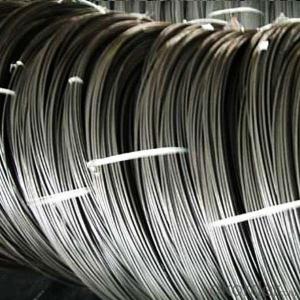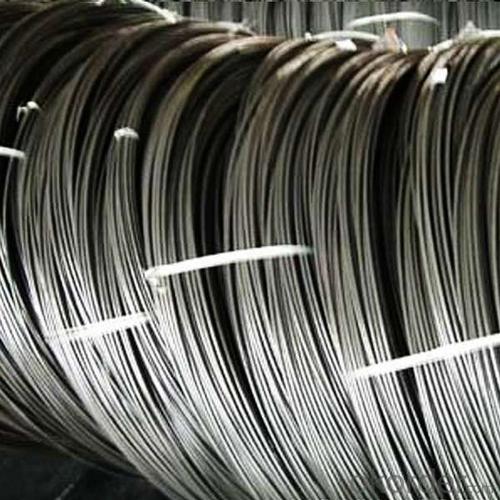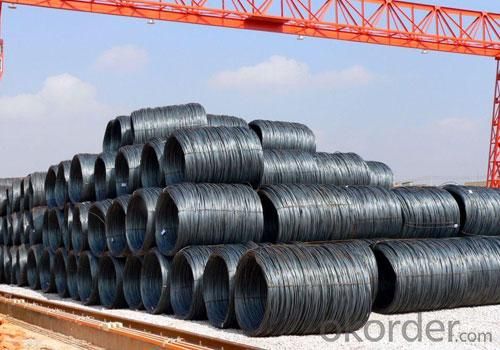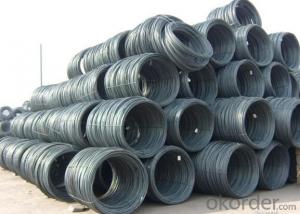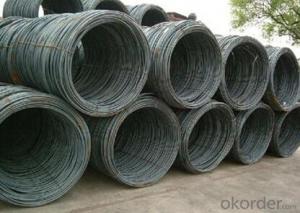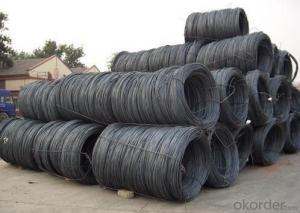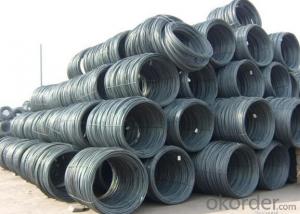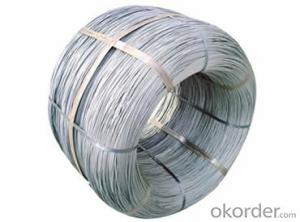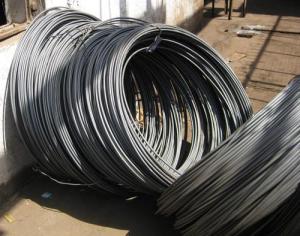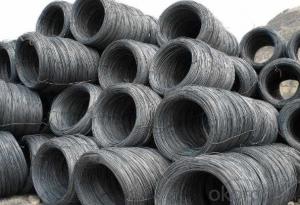Coils Steel Hot Rolled Wire Rod with Grade Q195
- Loading Port:
- Tianjin
- Payment Terms:
- TT OR LC
- Min Order Qty:
- 500 m.t.
- Supply Capability:
- 1000000 m.t./month
OKorder Service Pledge
OKorder Financial Service
You Might Also Like
1. Introduction:
.commodity:steel wire rod
.grade:Q195,SAE1008B-SAE1018B
.diameter:5.5mm-14mm
.type:in coil
.coil weight:around 2 mt
2. Specifications:
Coils Steel Hot Rolled Wire Rod Q195
.2013 Hot Sale Wire Rods: High dimensional accuracy, Composition uniformity, Good mechanical
.Grade: SAE1006/1008/1010/1018 , HPB235
.Diameter: 5mm/5.5mm/6mm/6.5mm-12mm
.Length: Wire rod in coil
. Application: Building/construction
. Packing: Standard export packing or as customers required
3.Application:
Applicationwidely used in machinery parts, manufacturing industry, electronics industry, metal tools and others
4. Pictures
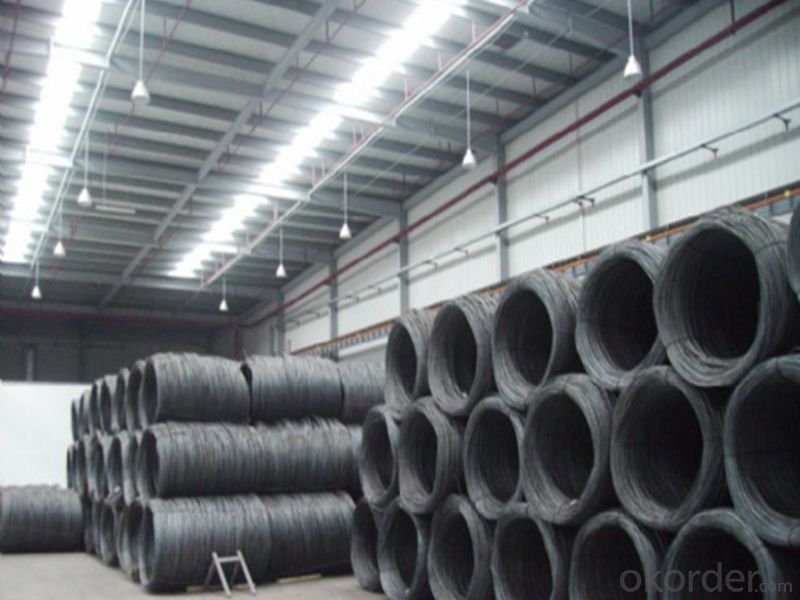
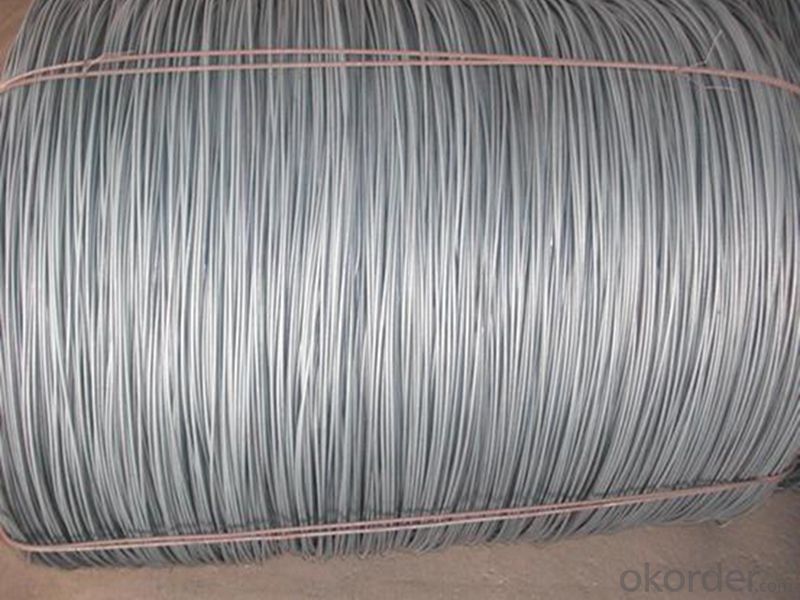
5.FAQ
We have organized several common questions for our clients,may help you sincerely:
①How about your company?
A world class manufacturer & supplier of castings forging in carbon steel and alloy steel,is one of the large-scale professional investment casting production bases in China,consisting of both casting foundry forging and machining factory. Annually more than 8000 tons Precision casting and forging parts are exported to markets in Europe,America and Japan. OEM casting and forging service available according to customer’s requirement.
②How to guarantee the quality of the products?
We have established the international advanced quality management system,every link from raw material to final product we have strict quality test;
- Q: How is steel wire rod processed into different wire products?
- Steel wire rod is processed into different wire products through a series of manufacturing processes. The first step involves the uncoiling of the steel wire rod, which is typically done using a machine called a pay-off reel. Once uncoiled, the wire rod is then cleaned to remove any dirt or rust using a pickling solution or shot blasting. After cleaning, the wire rod is passed through a series of rollers to reduce its diameter and increase its length. This process is called drawing, and it is usually done in multiple stages to achieve the desired thickness and strength. The wire rod is pulled through a die in each stage, gradually reducing its diameter. Once the wire has been drawn to the desired size, it is then annealed to relieve any internal stresses and improve its ductility. Annealing involves heating the wire to a specific temperature and then slowly cooling it down. This process makes the wire more flexible and easier to work with. Next, the wire may undergo additional processes such as galvanizing or coating. Galvanization involves dipping the wire in a bath of molten zinc to provide it with a protective layer against corrosion. Coating can be done using materials such as PVC or nylon to provide the wire with additional properties, such as insulation or increased strength. Finally, the wire is spooled onto reels or packaged into coils for transportation and storage. Depending on the specific wire product being manufactured, additional processes such as cutting, bending, or welding may be performed to shape the wire into its final form. Overall, the process of transforming steel wire rod into different wire products involves a combination of drawing, cleaning, annealing, and additional treatments to achieve the desired properties and dimensions. This complex process ensures that the wire products meet the required standards and are suitable for various applications in industries such as construction, automotive, and manufacturing.
- Q: What are the different types of tests performed on steel wire rod?
- There are several types of tests performed on steel wire rod to ensure its quality and suitability for various applications. These tests include: 1. Chemical Composition Analysis: This test determines the percentage of different elements present in the steel wire rod, such as carbon, manganese, silicon, sulfur, phosphorus, and other trace elements. It helps to ensure that the steel meets the required specifications. 2. Tensile Strength Test: This test measures the ability of the steel wire rod to withstand tension or pulling forces without breaking. It determines the maximum load the rod can bear before it fractures, providing crucial information about its strength and durability. 3. Elongation Test: This test determines the percentage increase in length the steel wire rod undergoes before it breaks under tension. It helps to assess the ductility and malleability of the rod, indicating its ability to withstand deformation without fracturing. 4. Hardness Test: This test measures the resistance of the steel wire rod to indentation or scratching. It provides an indication of the material's strength and ability to resist wear and tear. 5. Microstructure Analysis: This test involves examining the microstructure of the steel wire rod under a microscope. It helps to identify any structural anomalies, such as grain size, presence of inclusions, and uniformity, which can affect the rod's mechanical properties. 6. Surface Inspection: This test involves visually inspecting the surface of the steel wire rod for any defects, such as cracks, scratches, or surface irregularities. It ensures that the rod meets the required visual quality standards. 7. Dimensional Inspection: This test verifies the dimensional accuracy and tolerances of the steel wire rod, such as diameter, length, and straightness. It ensures that the rod meets the specified dimensional requirements for its intended application. 8. Corrosion Resistance Test: This test evaluates the steel wire rod's ability to resist corrosion when exposed to different environmental conditions. It helps to determine the rod's suitability for applications where corrosion resistance is critical. By performing these tests, manufacturers can ensure that the steel wire rod meets the necessary quality standards and is suitable for use in various industries, including construction, automotive, manufacturing, and infrastructure.
- Q: What are the common packaging methods for steel wire rod?
- The common packaging methods for steel wire rod include coiling the wire rod into coils or spools, bundling them with steel straps or wire ties, and placing them on wooden pallets or in wooden crates for safe transportation and storage.
- Q: What are the different types of wire rods for reinforcement made from steel wire rod?
- There are several different types of wire rods for reinforcement made from steel wire rod, including plain wire rods, deformed wire rods, and cold-drawn wire rods. Plain wire rods are smooth and have no surface deformations, while deformed wire rods have ridges or bumps along their surface to provide better grip and adhesion with concrete. Cold-drawn wire rods are manufactured through a process of drawing the wire through a series of dies, resulting in a smoother and more uniform product with enhanced strength and flexibility.
- Q: What are the different surface defects that can impact the corrosion resistance of steel wire rod?
- There are several surface defects that can impact the corrosion resistance of steel wire rod. These include scale, pits, scratches, and oxide inclusions. Scale refers to the thin layer of iron oxide that forms on the surface of steel during the manufacturing process. Pits are small cavities or depressions that can form on the surface due to localized corrosion. Scratches can provide a site for corrosion initiation and propagation. Oxide inclusions are foreign particles embedded in the steel, which can act as corrosion initiation sites. All these surface defects can compromise the corrosion resistance of steel wire rod, making it more susceptible to rust and corrosion.
- Q: How are steel wire rods used in the manufacturing of wire baskets?
- Steel wire rods are used in the manufacturing of wire baskets as the primary raw material. These rods are first processed and drawn into thinner wires, which are then woven or welded to form the basket's structure. The strength and durability of steel wire rods make them an ideal choice for creating sturdy and long-lasting wire baskets.
- Q: What are the main factors influencing the choice of steel wire rod order packaging marking options?
- When choosing the packaging marking options for steel wire rod orders, several factors come into play. Firstly, compliance with industry standards is crucial. Each industry may have its own specific requirements for markings on packaging materials. These standards ensure that the product can be easily identified and tracked throughout the supply chain. Adhering to these standards is essential for smooth operations and regulatory compliance. Secondly, customer requirements play a significant role. Customers may have specific labeling or marking preferences based on the destination of the product, their own branding needs, or other identification requirements. Meeting these requirements is vital for customer satisfaction and maintaining strong business relationships. Lastly, logistical considerations also impact the choice of packaging marking options. The way the steel wire rod orders are handled during transportation, storage, and loading/unloading can influence the placement of markings. For instance, if orders are frequently stacked or stored in specific orientations, the markings should be positioned accordingly to ensure easy identification and handling. Additionally, the size, shape, and material of the packaging itself need to be taken into account when determining the most suitable marking options. In conclusion, the choice of packaging marking options for steel wire rod orders is influenced by industry standards, customer requirements, and logistical considerations. By carefully considering these factors, businesses can ensure effective and efficient packaging marking solutions that meet the needs of all stakeholders involved.
- Q: Can steel wire rod be used in the production of automotive parts?
- Yes, steel wire rod can be used in the production of automotive parts. It is commonly used to manufacture various components such as springs, cables, and reinforcements due to its high strength and durability.
- Q: How is steel wire rod used in the manufacturing of wire forms for security fencing?
- The manufacturing of wire forms for security fencing relies heavily on steel wire rod. This essential component serves as the primary raw material for constructing strong and durable wire fences. To enhance its properties, such as strength, flexibility, and resistance to corrosion, steel wire rod undergoes a series of mechanical and chemical treatments. This ensures that the resulting wire forms can withstand harsh weather conditions, physical impact, and attempts at breaching. Once prepared, the steel wire rod is shaped and sized according to the specific requirements of the security fencing. This can involve creating straight wires, coils, or even intricate designs like barbed wire or razor wire, depending on the desired level of security. The wire forms are then assembled and connected to form the desired structure of the security fence. This can be achieved through techniques such as weaving, welding, or fastening with specialized tools. The strength and durability of the steel wire rod guarantee that the fence will maintain its structural integrity and resist any attempts to cut, break, or tamper with it. In addition, the steel wire rod can also be galvanized or coated with protective layers to enhance its resistance to corrosion, rust, and other environmental factors. This further extends the lifespan of the security fence and reduces the need for frequent maintenance or replacement. In conclusion, the crucial role of steel wire rod in the manufacturing of wire forms for security fencing cannot be overstated. Its strength, durability, and resistance to corrosion make it the ideal material for creating robust and long-lasting fences that provide effective security measures.
- Q: How is steel wire rod cut to desired lengths?
- Wire drawing is a common method used to cut steel wire rod into desired lengths. By pulling the steel rod through a series of dies, its diameter gradually decreases. This not only shapes the wire to the desired size but also enhances its strength and flexibility. The wire drawing process can be carried out either manually or with automated machinery, depending on the production scale. Once the wire reaches the desired diameter, it can be cut into specific lengths using various cutting techniques, such as shearing or sawing. These cutting methods can be performed manually or with specialized cutting equipment. In conclusion, the process of cutting steel wire rod to desired lengths involves shaping the wire through wire drawing and then using appropriate cutting methods for precision.
Send your message to us
Coils Steel Hot Rolled Wire Rod with Grade Q195
- Loading Port:
- Tianjin
- Payment Terms:
- TT OR LC
- Min Order Qty:
- 500 m.t.
- Supply Capability:
- 1000000 m.t./month
OKorder Service Pledge
OKorder Financial Service
Similar products
Hot products
Hot Searches
Related keywords
